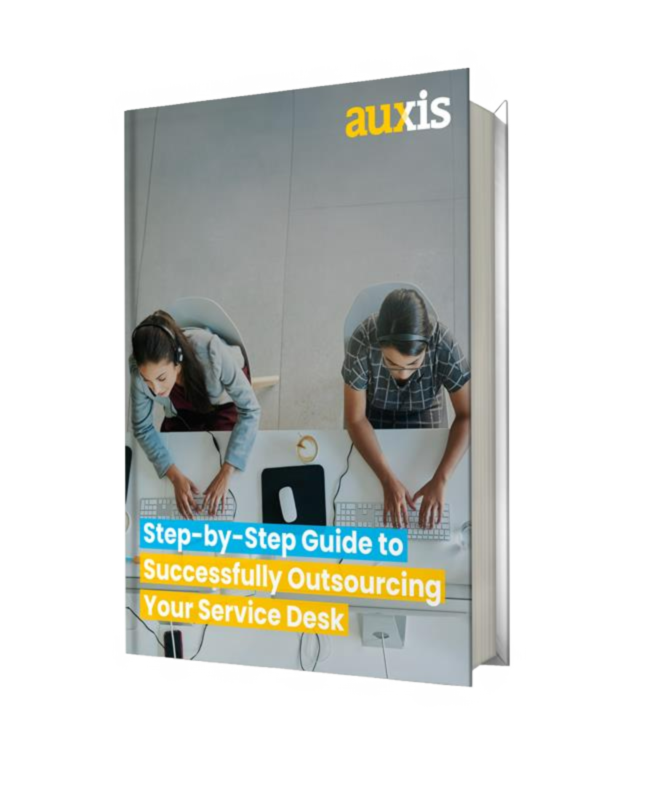It’s one thing to have to wait in long hold queues when you’re calling your cable company for help desk services, but quite another when you’re being asked to hold from within your own company. Understanding common help desk problems and solutions is vital for quickly and effectively resolving technical issues that can keep your business from running smoothly.
But providing high-quality support isn’t as simple as it seems. Without the right structure and process efficiency, technical support can become an overwhelming time-drain that distracts IT from more critical competencies.
Ultimately, the help desk gets stuck in a “break/fix” approach with poor and inconsistent service levels, high costs, inadequate schedules, an outdated knowledge base, and limited documentation or metrics.
Achieving a modern, high-performance service desk delivers cost optimizations, process maturity, and proactive management that can resolve 80% of user issues. Proactively identifying and resolving potential issues is key to optimizing your support service in a big-picture way.
In this blog, we will examine common help desk problems and solutions for overcoming them.
Why companies struggle to create high-performance service desks
1. Failing to establish a dedicated help desk team.
Many corporations maintain IT teams who act as jacks of all trades. Although this might seem like an efficient use of resources, it’s anything but.
Without dedicated help desk staff, valuable, highly trained employees often waste time on jobs that could be outsourced or handled by a junior staff member.
However, tightening budgets and mounting pressure for IT to create strategic value across different departments make it hard for internal help desks to receive enough funding. The severe IT labor shortage also has many IT Departments stretched too thin, lacking the resources for a dedicated support structure.
2. High turnover.
If CIOs do manage to hire talent, retention is a major concern: North American help desks experience average turnover of 40% per year.
When your employees see the help desk as a brief stop on their career path rather than a destination, service levels suffer dramatically. Turnover creates inconsistent service, making it difficult to generate reliable metrics because so many people are either training or in the process of moving on at any given time.
3. Lack of documented procedures.
A “laissez-faire” approach to the help desk rarely works for long, especially if your business has grown considerably since your help desk staff was hired. If your employees lack documented procedures or frequent training to keep them on the same page, chances are high they’re also not implementing service in any consistent way.
A lack of documented procedures also typically means there’s no structure for handling tickets and escalations, or the organization required to keep a system running smoothly in the first place.
Such inefficient practices increase end-user IT costs dramatically: both directly in manpower and indirectly in lost work hours.
Building a high-performance service desk delivers the customer-centric approach that’s lacking in the traditional help desk model. It utilizes best practices, dedicated resources, and advanced technology to consistently deliver high-quality, timely support tailor-made to business needs. Including:
2025 Auxis Help Desk Report: A Step-by-Step Guide to Successfully Outsourcing your Service Desk

- A service catalog mapped to business needs with clearly defined support levels.
- A robust, continuously updated knowledge base and training program.
- Detailed documentation and repeatable processes that allow anyone to deliver consistent performance.
- Flexible interfaces that enable end-users to access support via multiple channels, including self-service.
- Real-time analytics to proactively monitor and improve team performance.
- Multilingual capabilities, if needed.
- Automation to speed core processes.
- Remote access support.
4. Treating all help desk tickets the same.
If CIOs do manage to hire talent, retention is a major concern: North American help desks experience average turnover of 40% per year.
When your employees see the help desk as a brief stop on their career path rather than a destination, service levels suffer dramatically. Turnover creates inconsistent service, making it difficult to generate reliable metrics because so many people are either training or in the process of moving on at any given time.
5. Assuming Level 1 support can handle everything.
L1 agents need to act quickly, so their wheelhouse is basic end-user support. But too often, organizations have unrealistic expectations over the complexity of issues L1 can resolve.
Activities like printer support and machine maintenance are generally better serviced by an experienced vendor. Less-common technologies are difficult to support in the L1 tier as well.
Security and compliance factors can further complicate help desk support, with some technical resources requiring access permission assigned to higher support tiers.
Level-setting at the start ensures everyone understands the service desk’s role in the IT support model. To create clear expectations, define what issues are covered at every level – not just L1.
You also should clarify what the escalation points are and who will provide higher levels of support across key applications and infrastructure.
6. The fallacy of price per ticket.
When it comes to price per ticket, you get what you pay for. Outsourced solutions that look attractive on the surface with cheap L1 ticket servicing often hide ugly surprises, like poorly trained staff and frequent ticket escalations.
Typically, vendors need high volumes and low service delivery expectations for a low cost-per-ticket model to work.
Make sure you do your homework to understand what makes low pricing possible. While outsourcing can reduce labor costs, high-quality support still requires a well-structured team with properly trained managers, leads, and staff who speak the right languages and maintain the right experience and customer skills.
Exceptional service also involves other labeled-in costs, such as a solid support structure with strong procedures and documentation and best-in-class tools for the call center, chat, ticketing system, and reporting.
7. Neglecting to create a help desk Center of Excellence.
There’s more behind the scenes of a high-quality service desk than agents fixing issues. Failing to govern best practices and continuous improvement by establishing a Center of Excellence (CoE) as part of your model sets you up for poor performance.
A CoE creates a structure through which team members can measure, innovate, and drive each other toward excellence. For your service desk, key CoE supporting roles should include Training, Quality Assurance (QA), Workforce Management (WFM), Knowledge Management (KM), and Reporting.
8. Basing staff solely on ticket volumes.
Ticket volume is a key consideration in determining an optimal service desk staffing ratio. Gartner estimates that the average employee contacts the help desk 0.8 to 1.5 times per month, and help desk agents can only handle a limited number of requests during that timeframe.
But basing staffing levels solely on ticket volumes fails to properly consider other factors that impact a service desk’s ability to manage its workload, like service-level expectations, hours of coverage, and ticket complexity. With too few resources, service quality will plummet as the help desk struggles to effectively respond to all requests promptly.
Nearshoring: the solution to common help desk problems
Modern challenges like remote work and fast-tracked digital transformation make operating a high-quality service desk more important than ever. But it’s also becoming more difficult to get right.
Not surprisingly, CIOs are increasingly turning to outsourcing to deliver higher-quality technical support faster and more cost-effectively – with investment in help desk services growing from 25% to 50% nationwide.
Latin America has emerged as a hot spot for North American organizations considering outsourcing, overcoming many challenges that plague Asian-based solutions like cultural and language barriers and the difficulty of doing business across faraway time zones.
Companies often underestimate what’s required to produce quality help desk support in-house – lacking the time, resources, or expertise to develop exceptional processes for training, onboarding, transition, knowledge management, reporting, and more.
Reputable help desk outsourcers already have the tools, processes, best practices, and skilled talent in place to instantly upscale end-user experiences and meet the growing technology needs of your business.



